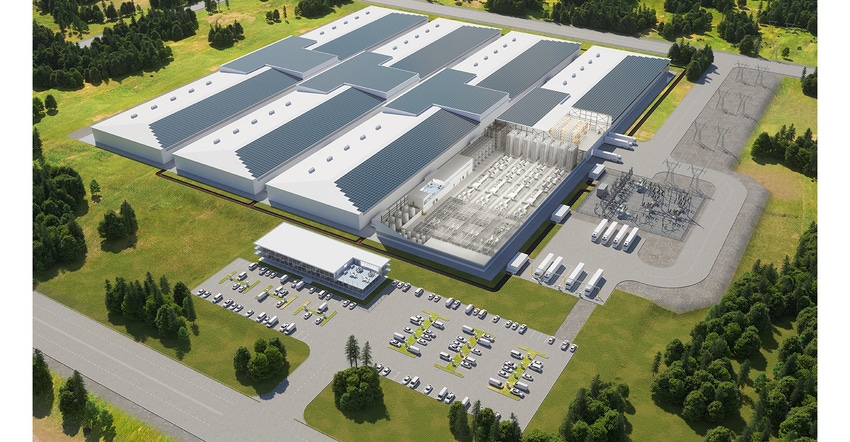Optimizing Battery Manufacturing at the Factory Level
Digital integration, enabling a cohesive, digital view of a plant’s operations, is essential: ABB explains why.
September 11, 2023

Staffan Södergård, ABB Business Unit Manager, Battery Manufacturing, Process Industries
Battery cell manufacturing is experiencing a period of rapid expansion. According to McKinsey’s Battery 2030 report, demand for lithium-ion batteries is expected to grow from 700 GWh in 2022 to 4,700 GWh in 2030, an annual rise of 27 percent.¹
Clearly, the US Inflation Reduction Act has changed the landscape in the sector. Under the act, battery manufacturers are eligible for an “advanced manufacturing production credit” worth $35 per kWh of annual capacity. In the US, the scale of the government’s ambitions has led to real investment in gigafactory projects from major automotive companies and could lead to a similar impact in other sectors. In fact, the US Department for Energy has said it expects North America's battery manufacturing capacity to rise from 55 GWh per year in 2021 to nearly 1,000 GWh per year by 2030.
Globally, the race is on
China remains the world leader in electric vehicle (EV) battery production, but the political drive to “derisk” supply chains around emerging technologies means Europe and the US are catching up. The International Energy Agency predicts that China’s share of EV battery demand will decline from over 55 percent in 2022, to around 35 percent in 2030.
So, clearly, the sector is growing at a frenetic pace. The same McKinsey report said that, in total, at least 120 to 150 new battery factories will need to be built between now and 2030 globally to meet demand. The race is on.
Building the necessary manufacturing capabilities to meet these burgeoning demands requires both speed and agility to ensure battery cell production stays on pace. But this brings with it issues. Battery manufacturers face fierce cost pressures, ever-increasing demands for greater quality, traceability, and faster times to market. These stem from a variety of sources, including a strained supply chain of critical minerals, and new applications such as energy storage and automotive requiring new and refined battery designs. A maturing market for EVs and consumer sentiment also lead to demand for greater proof of sustainability and quality.
The traditional approach will no longer do
How, then, to mitigate these challenges? Unfortunately, the traditional approach to building greenfield gigafactories does not help. Here, design input matures piecemeal throughout the project, and the construction of a new facility often involves a wide assortment of subcontractors, each of whom has their own engineering solutions and third-party system integrators. This can result in a mix of electrification, instrumentation, and control packages that are somewhat disjointed.
A change to one element of the project can have a domino effect on the entire supply chain. All of this can easily result in costly delays due to long lead times, extra engineering, re-engineering, and/or postponements. In a sector experiencing exponential growth, as battery manufacturing is, time to market is crucial.
When a factory does come online, the lack of virtual commissioning makes the ramp-up period slower. More time must be spent testing interfaces, making adjustments, and troubleshooting each and every individual machine before you can move on to commissioning the full production line.
Digital integration from the start
By engaging a technology partner such as ABB at the very beginning, manufacturers can prioritize integration and interoperability upfront. This helps with project standardization but also provides seamless digital integration and transparency to ensure operational efficiency. This can save time and money while making operations more efficient and preserving uptime.
Through its Plant Optimization Methodology, ABB offers single-source integration of electrification, automation, instrumentation, and digital coupled with a proven path to help build a world-class, fully connected, flexible, and self-optimizing battery factory.
On top of operational efficiency, another concern for manufacturers is sustainability. Driven as it has been by the growth in the EV market, this should be a constant focus for battery manufacturers. From traceability of the critical minerals to the plant’s carbon footprint to waste in the production process itself, the demands can become cumbersome.
A cohesive, digital view of a plant’s operations means manufacturers can limit the amount of off-specification material by predicting where there might be a quality variation, and act to correct that. This leads to significantly less waste.
Traceability demands met
As adoption and applications of batteries grow, expect to see demand for battery passports, which contain the genealogy of an individual battery cell, rise up the agenda too. Some elements of a battery are easy to trace back to which mine or facility they came from. But later, the chemical process becomes complicated, it’s a continuous process with different stages. ABB can trace that in a digital format, looking at how the material flows, and work backwards to understand the origins of different batches. Improving the traceability allows customers to set quality parameters and then gradually improve on those. They can judge cause and effect, see where there’s a disturbance in the process and what the impact is.
This overall optimization approach has already been put into practice with great effect by Northvolt, one of Europe’s leading battery manufacturers. In Skellefteå, a town about 500 miles north of Stockholm, Northvolt Ett has a full capacity for 60 GWh, enough to supply batteries for around one million EVs a year. ABB has been a trusted partner throughout the process.
The sector will continue to grow in the year ahead, as planned capacity comes online. New sectors, such as energy storage or aerospace, will bring their own methods to optimize production. While battery manufacturers prepare their design-build plans, keep in mind the challenges in optimizing at a factory-wide level. Any issues or oversight will be amplified. You should be prepared.

You May Also Like



